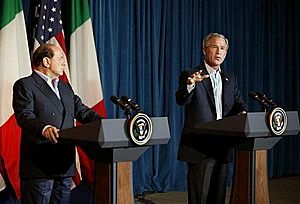Center-right facts for kids
Centre-right politics describes political ideas that are on the right side of the political spectrum, but are closer to the middle. People who support centre-right ideas generally believe in liberal democracy, which means a government elected by the people. They also support capitalism, where businesses are mostly owned by private individuals, and a market economy, where prices are set by supply and demand.
Centre-right ideas also include protecting private property and having a small welfare state. A welfare state is when the government helps people with things like healthcare or education. They often support conservatism, which means keeping traditional values, and economic liberalism, which means less government control over the economy. They usually do not support socialism or communism, which involve more government control.
Contents
What are Centre-Right Ideas?
Centre-right ideas include things like liberal conservatism. This mixes traditional values with ideas about individual freedom. Some types of liberalism and Christian democracy also fit here. Christian democracy is a political movement that uses Christian teachings as its base.
How Centre-Right Views the Economy
Modern centre-right politics is often shaped by economic liberalism. This means they usually support free markets, where businesses can trade freely without much government interference. They also believe in limited government spending. This means the government should not spend too much money.
Where Did Centre-Right Ideas Come From?
Historically, there have been different groups that showed centre-right thinking. In the United Kingdom, there was something called One Nation Conservatism. This idea focused on uniting all parts of society. In Canada, some politicians were called Red Tories. They were conservatives who also supported some social programs. In the United States, Rockefeller Republicans were a group of Republicans who were more moderate.
New Democrats and Centre-Right Ideas
In the United States, the New Democrats also adopted some centre-right policies. These included trying to have balanced budgets, where the government doesn't spend more than it earns. They also supported free trade, which means trading goods between countries without many taxes or rules. Other ideas included deregulation, which means reducing government rules on businesses, and welfare reform, which changed how government aid was given out.
These centre-right groups are different from far-right politics or right-wing populism. Far-right ideas are much more extreme. Centre-right groups also tend to be more open to cultural liberalism, which means accepting different lifestyles. They might also support green conservatism, which combines environmental protection with conservative ideas.
Centre-Right Politics Today
A study from 2019 looked at 21 Western countries. It found that centre-right parties received about 27% of the votes in 2018. This was a decrease from 37% in 1960. This shows that their support has gone down over time in these countries.
See also
 In Spanish: Centroderecha política para niños
In Spanish: Centroderecha política para niños


